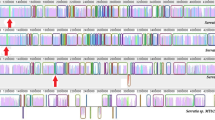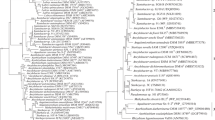Abstract
Key enzymes of aromatic amino acid biosynthesis were examined in the genus Acinetobacter. Members of this genus belong to a suprafamilial assemblage of Gram-negative bacteria (denoted Superfamily B) for which a phylogenetic tree based upon oligonucleotide cataloging of 16S rRNA exists. Since the Acinetobacter lineage diverged at an early evolutionary time from other lineages within Superfamily B, an examination of aromatic biosynthesis in members of this genus has supplied improtant clues for the deduction of major evolutionary events leading to the contemporary aromatic pathways that now exist within Superfamily B. Together with Escherichia coli, Pseudomonas aeruginosa and Xanthomonas campestris, four well-spaced lineages have now been studied in comprehensive detail with respect to comparative enzymological features of aromatic amino acid biosynthesis. A. calcoaceticus and A. lwoffii both possess two chorismate mutase isozymes: one a monofunctional isozyme (chorismate mutase-F), and the other (chorismate mutase-P) a component of a bifunctional P-protein (chorismate mutase-prephenate dehydratase). While both P-protein activities were feedback inhibited by l-phenylalanine, the chorismate mutase-P activity was additionally inhibited by prephenate. Likewise, chorismate mutase-F was product inhibited by prephenate. Two isozymes of 3-deoxy-d-arabino-heptulosonate 7-phosphate synthase were detected. The major isozyme (>95%) was sensitive to feedback inhibition by l-tyrosine, whereas the minor isozyme was apparently insensitive to allosteric control. Prephenate dehydrogenase and arogenate dehydrogenase activities were both detected, but could not be chromatographically resolved. Available evidence favors the existence of a single dehydrogenase enzyme, exhibiting substrate ambiguity for prephenate andl-arogenate. Dehydrogenase activity with either of the latter substrates was specific for NADP+, NAD+ being ineffective. Consideration of the phylogeny of Superfamily-B organisms suggests that the stem ancestor of the Superfamily possessed a single dehydrogenase enzyme having ambiguity for both substrate and pyridine nucleotide cofactor. Since all other members of Superfamily B have NAD+-specific dehydrogenases, specialization for NADP+ must have occurred following the point of Acinetobacter divergence, leading to the dichotomy seen in present-day Superfamily-B organisms.
Similar content being viewed by others
References
Berry A, Byng GS, Jensen RA (1985a) Interconvertible molecularweight forms of the bifunctional chorismate mutase-prephenate dehydratase from Acinetobacter calcoaceticus Arch Biochem Biophys (in press)
Berry A, Johnson JL, Jensen RA (1985b) Phenylalanine hydroxylase and isozymes of 3-deoxy-d-arabino-heptulosonate 7-phosphate synthase in relationship to the phylogenetic position of Pseudomonas acidovorans (Ps. sp. ATCC 11299a). Arch Microbiol 141:32–39
Bradford MM (1976) A rapid and sensitive method for the quantitation of microgram quantities of protein utilizing the principle of protein-dye binding. Anal Biochem 72:248–254
Byng GS, Whitaker RJ, Gherna RL, Jensen RA (1980) Variable enzymological patterning in tyrosine biosynthesis as a means of determining natural relatedness among the Pseudomonadaceae. J Bacteriol 144:247–257
Byng GS, Kane JF, Jensen RA (1982) Diversity in the routing and regulation of complex biochemical pathways as indicators of microbial relatedness. Crit Rev Microbiol 9:227–252
Byng GS, Berry A, Jensen RA (1983a) A pair of regulatory isozymes for 3-deoxy-d-arabino-heptulosonate 7-phosphate synthase is conserved within group I pseudomonads. J Bacteriol 156:429–433
Byng GS, Johnson JL, Whitaker RJ, Gherma RL, Jensen RA (1983b) The evolutionary pattern of aromatic amino acid biosynthesis and the emerging phylogeny of pseudomonad bacteria. J Mol Evol 19:272–282
Byng GS, Whitaker RJ, Jensen RA (1983c) Evolution of l-phenylalanine biosynthesis in rRNA homology group I of Pseudomonas. Arch Microbiol 136:163–168
Calhoun DH, Pierson DL, Jensen RA (1973) Channel-shuttle mechanism for the regulation of phenylalanine and tyrosine synthesis at a metabolic branchpoint in Pseudomonas aeruginosa. J Bacteriol 113:241–251
Cotton RGH, Gibson F (1965) The biosynthesis of phenylalanine and tyrosine: enzymes converting chorismic acid into prephenic acid and their relationship to prephenate dehydratase and prephenate dehydrogenase. Biochim Biophys Acta 100:76–88
Davidson BE, Blackburn EH, Dopheide TAA (1972) Chorismate mutase-prephenate dehydratase from Escherichia coli K-12. I. Purification, molecular weight and amino acid composition. J Biol Chem 247:4441–4466
Dayan J, Sprinson DB (1970) Preparation of prephenic acid. In: Tabor H, Tabor CW (eds) Methods in enzymology, vol 17 A. Academic Press, New York, pp 559–561
Dayan J, Sprinson DB (1971) Enzyme alterations in tyrosine and phenylalanine auxotrophs of Salmonella typhimurium. J Bacteriol 108:1174–1180
Fazel AM, Jensen RA (1980) Regulation of prephenate dehydratase in coryneform species of bacteria by l-phenylalanine and by remote effectors. Arch Biochem Biophys 200:165–176
Fiske MJ, Whitaker RJ, Jensen RA (1983) Hidden overflow pathway to l-phenylalanine in Pseudomonas aeruginosa. J Bacteriol 154:623–631
Fox GE, Stackebrandt E, Hespell RB, Gibson J, Maniloff J, Dyer TA, Wolfe RS, Balch WE, Tanner RS, Magrum LJ, Zablen LB, Blakemore R, Gupta R, Bonen L, Lewis BJ, Stahl DA, Luehrsen KR, Chen KN, Woese CR (1980) The phylogeny of prokaryotes. Science 209:457–463
Gibson F (1964) Chorismic acid: Purification and some chemical and physical studies. Biochem J 90:256–261
Jensen RA (1985) Biochemical pathways in prokaryotes can be traced backwards through evolutionary time. Mol Biol Evol 2:92–108
Jensen RA, Nester EW (1966) Regulatory enzymes of aromatic amino acid biosynthesis in Bacillus subtilis. I. Purification and properties of 3-deoxy-d-arabino-heptulosonate 7-phosphate synthetase. J Biol Chem 241:3365–3372
Jensen RA, Calhoun DH, Stenmark SL (1973) Allosteric inhibition of 3-deoxy-d-arabino-heptulosonate 7-phosphate synthetase by tyrosine, tryptophan and phenylpyruvate in Pseudomonas aeruginosa. Biochim Biophys Acta 293:256–268
Jensen RA, Zamir LO, St Pierre M, Patel N, Pierson DL (1977) The isolation and preparation of pretyrosine accumulated as a dead-end metabolite by Neurospora crassa. J Bacteriol 132: 896–903
Johnson JL, Anderson RS, Ordal EJ (1970) Nucleic acid homologies among oxidase-negative Moraxella species. J Bacteriol 101: 568–573
Koch GLE, Shaw DC, Gibson F (1970) Tyrosine biosynthesis in Aerobacter aerogenes. Purification and properties of chorismate mutase-prephenate dehydrogenase. Biochim Biophys Acta 212:375–386
Koch GLE, Shaw DC, Gibson F (1971) The purification and characterization of chorismate mutase-prephenate dehydrogenase from Escherichia coli K-12. Biochim Biophys Acta 229:795–804
Patel N, Pierson DL, Jensen RA (1977) Dual enzymatic routes to l-tyrosine and l-phenylalanine via pretyrosine in Pseudomonas aeruginosa. J Biol Chem 252:5839–5846
Patel N, Stenmark-Cox SL, Jensen RA (1978) Enzymological basis of reluctant auxotrophy for phenylalanine and tyrosine in Pseudomonas aeruginosa. J Biol Chem 253:2972–2978
Schmit JC, Zalkin H (1969) Chorismate mutase-prephenate dehydratase. Partial purification and properties of the enzyme from Salmonella typhimurium. Biochemistry 8:174–181
Shapiro CL, Jensen RA, Wilson KA, Bowen JR (1981) An assay for activity of arogenate dehydratase based upon the selective oxidation of arogenate. Anal Biochem 110:27–30
Srinivasan PR, Sprinson DB (1959) 2-keto-3-deoxy-d-arabo-heptonic acid 7-phosphate synthetase. J Biol Chem 234:716–722
Stackebrandt E, Woese CR (1981) The evolution of prokaryotes. In: Carlile MJ, Collins JF, Moseley BEB (eds) Molecular and cellular aspects of microbial evolution, 32nd Symp Soc Gen Microbiol. Cambridge Univ Press, Cambridge, pp 1–32
Whitaker rJ, Fiske MJ, Jensen RA (1982) Pseudomonas aeruginosa possesses two novel regulatory isozymes of 3-deoxy-d-arabino heptulosonate 7-phosphate synthase. J Biol Chem257:12789–12794
Whitaker RJ, Berry A, Byng GS, Fiske MJ, Jensen RA (1985) Clues from Xanthomonas campestris about the evolution of aromatic biosynthesis and its regulation. J Mol Evol 21:139–149
Zamir LO, Jensen RA, Arison BH, Douglas AW, Albers-Schonberg G, Bowen JR (1980) Structure of arogenate (pretyrosine), an amino acid intermediate of aromatic biosynthesis. J Am Chem Soc 102:4499–4504
Author information
Authors and Affiliations
Rights and permissions
About this article
Cite this article
Byng, G.S., Berry, A. & Jensen, R.A. Evolutionary implications of features of aromatic amino acid biosynthesis in the genus Acinetobacter . Arch. Microbiol. 143, 122–129 (1985). https://doi.org/10.1007/BF00411034
Received:
Accepted:
Issue Date:
DOI: https://doi.org/10.1007/BF00411034




